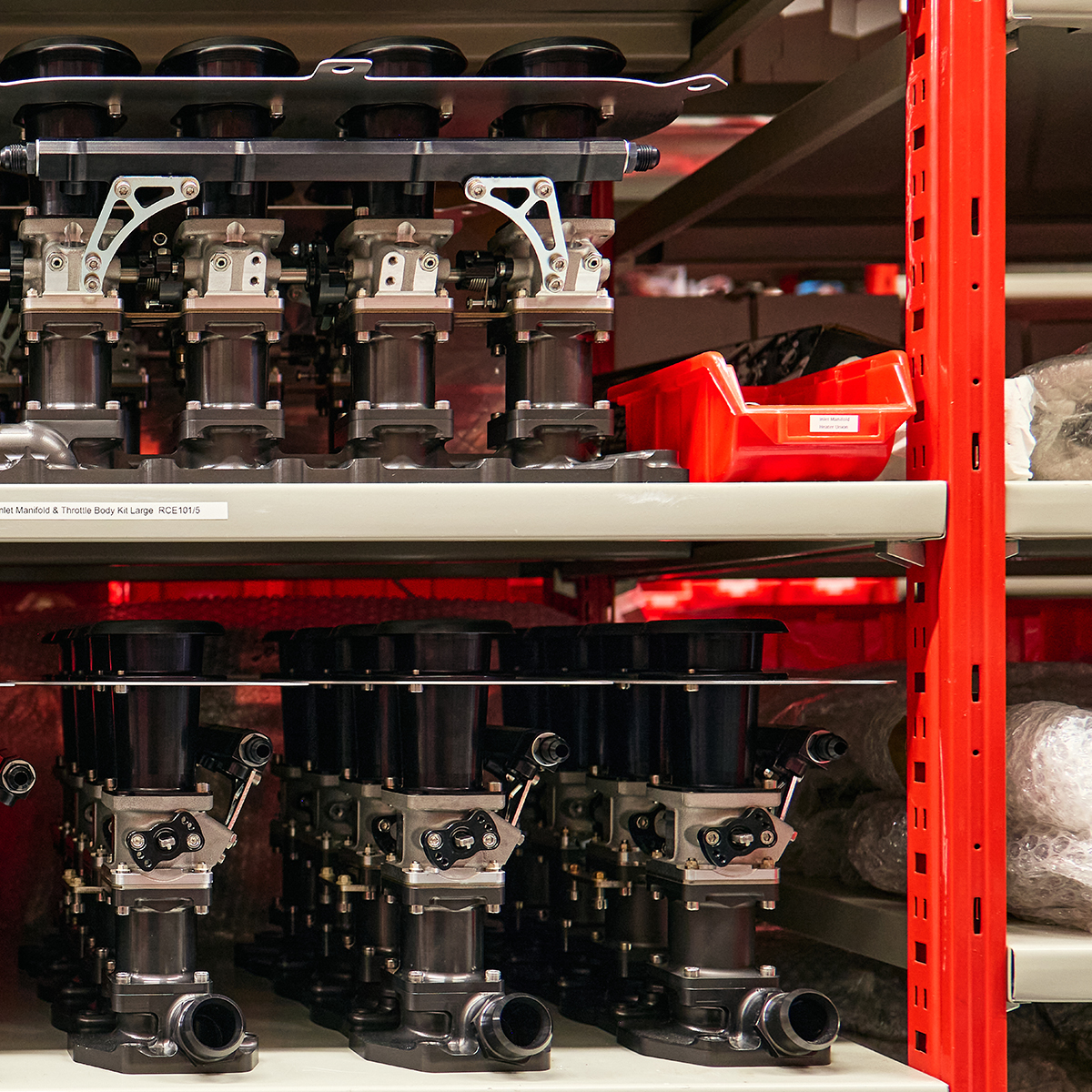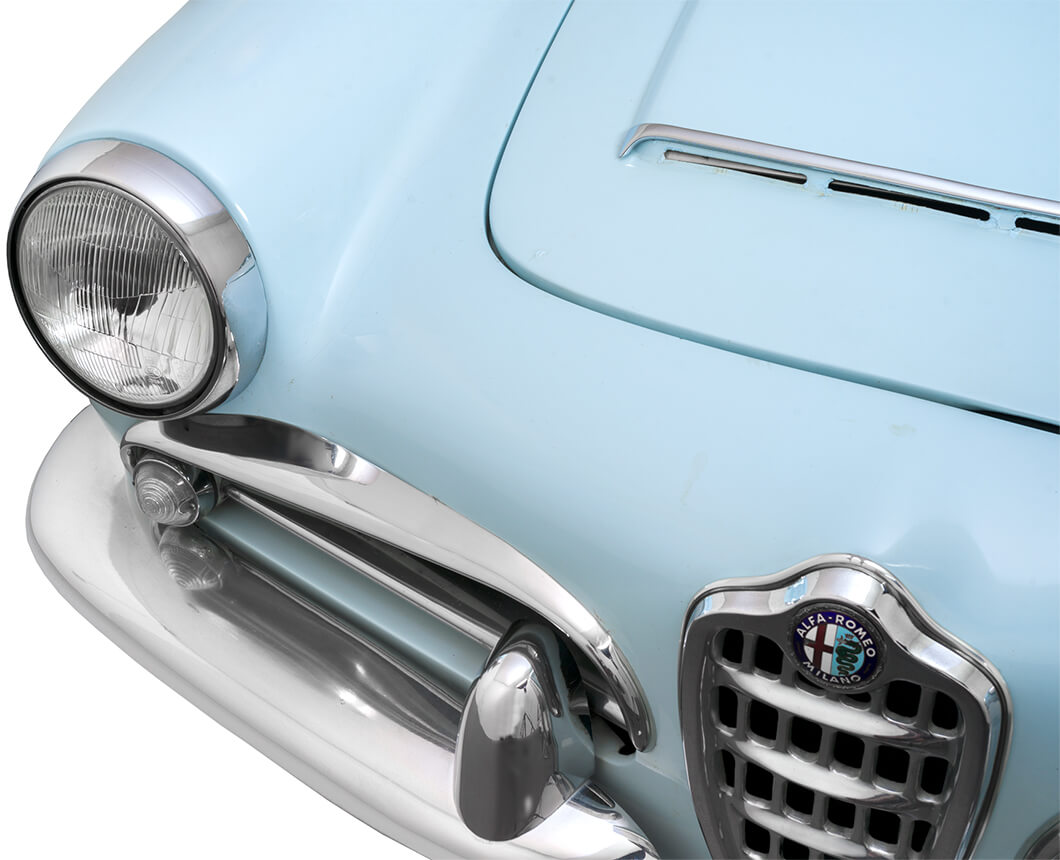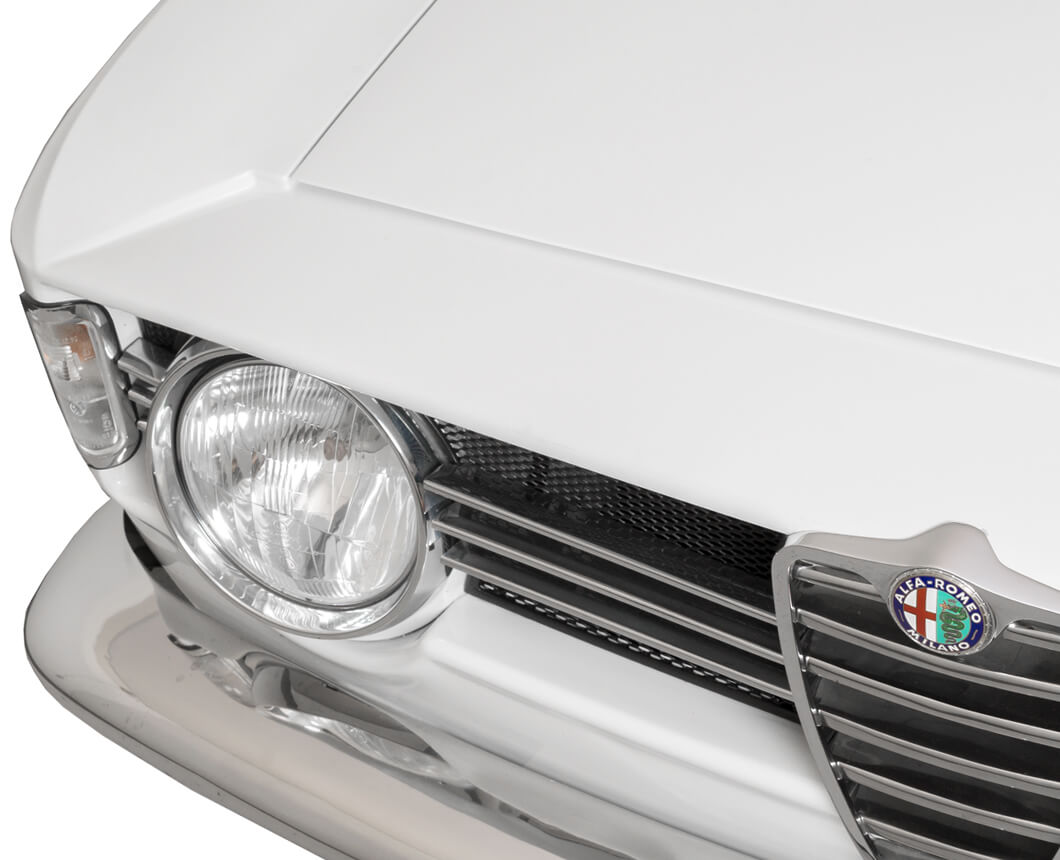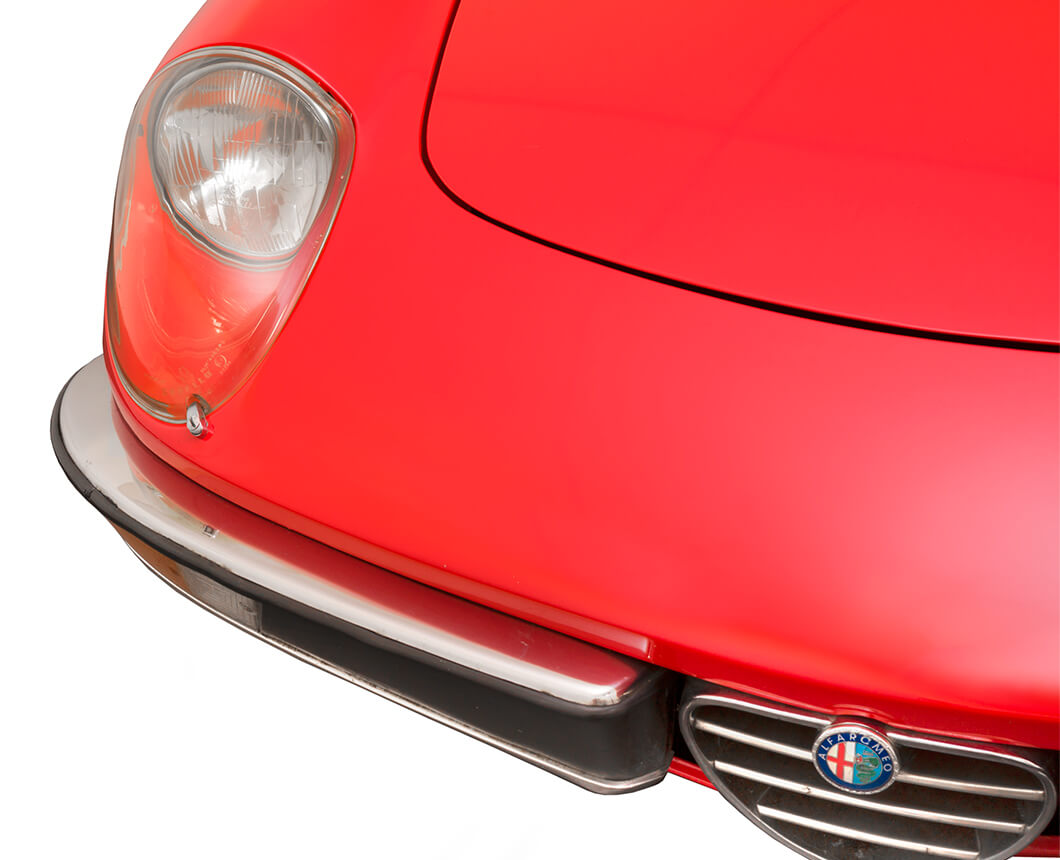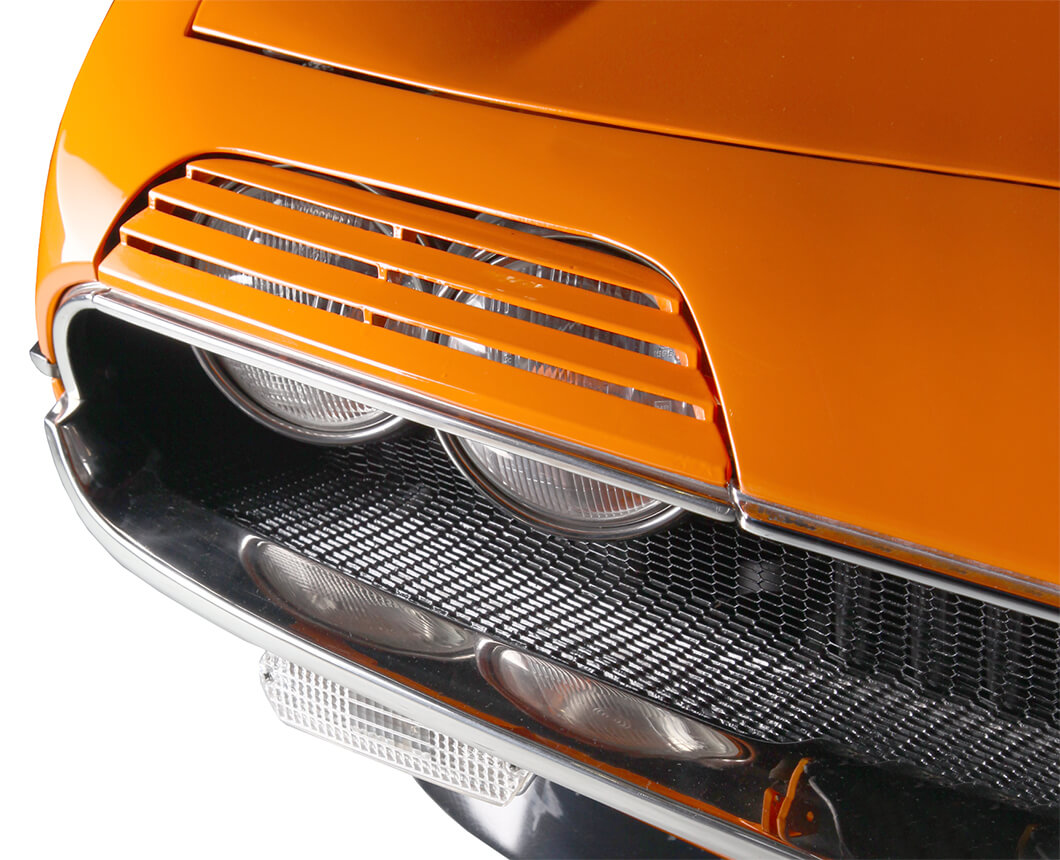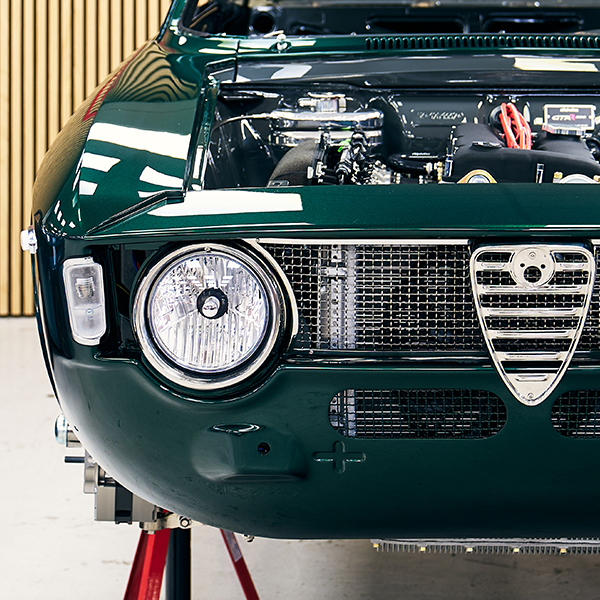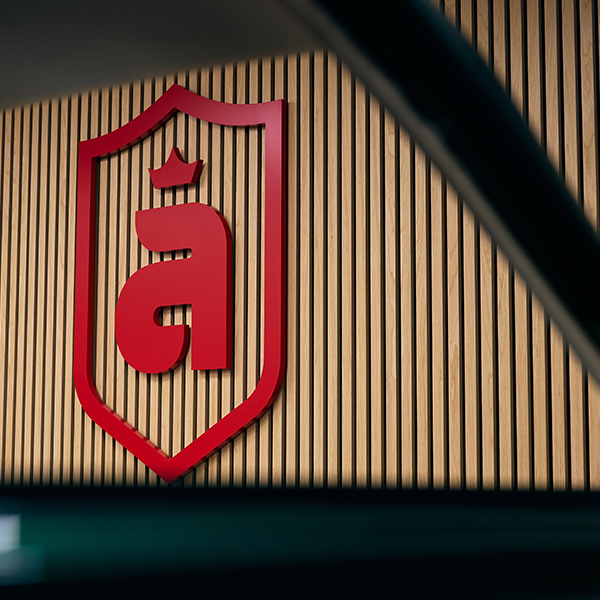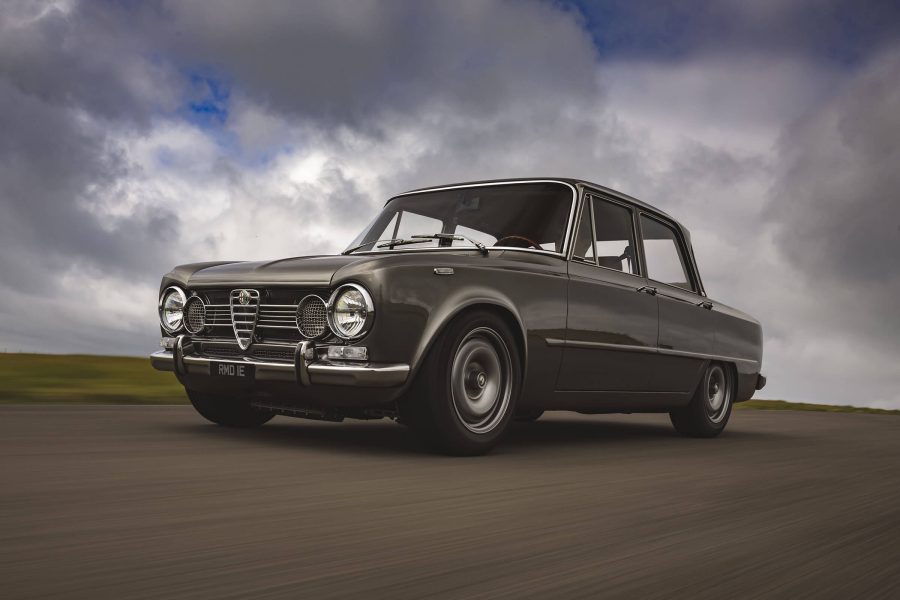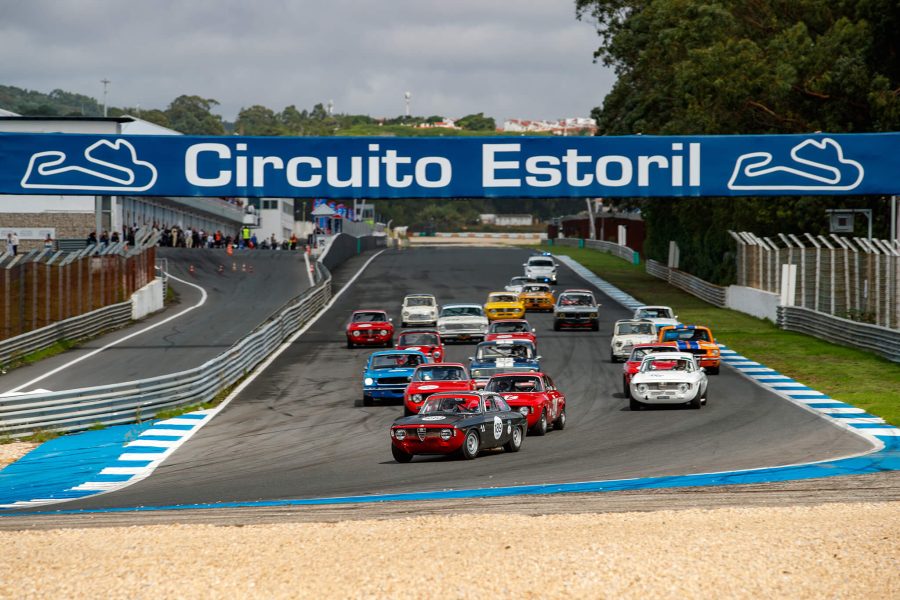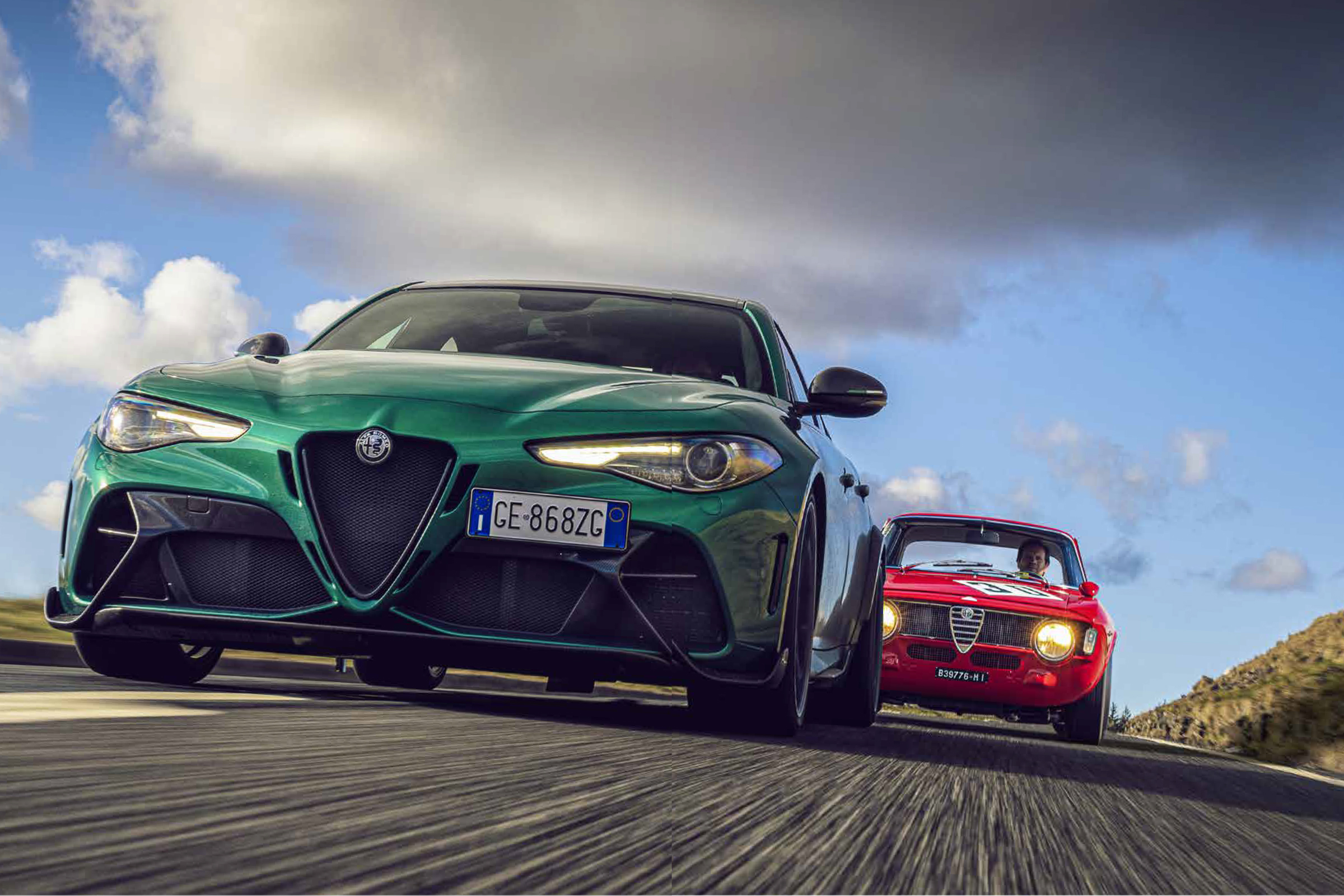
Delta Force
Autodelta is to Alfa what M is to BMW. In the ’60s, its fast Giulia GTAs won races and stole hearts. Can the wild new Giulia GTAm do the same?
Car Magazine
Words: Ben Barry
Photography: Jordan Butters
Imagine Jochen Rindt hadn’t died during practice for the Monza GP in 1970, and instead the 28-year-old Austrian walked away from his Lotus F1 car’s wreckage, then took race-day off to visit Alfa Romeo’s Autodelta works team at Balocco. Autodelta co-founder Carlo Chiti would’ve wel- comed Rindt in this parallel universe, before inviting him to drive the Giulia Sprint GTA he’d steered to victory in Karlskoga, Sweden, four years earlier. Every detail would be preserved exactly as he last raced it.
If it’s a romantic notion, that’s the gist of the blood-red 1600 GTA Corsa featured here, which has been impec- cably restored by Bristol-based specialists Alfaholics to freeze-frame that victorious moment. It’s chassis number AR613102, the very car raced by Rindt three times (including that Swedish win), the little racing seat retains its original ribbed vinyl upholstery, the four-cylinder twin-cam and close-ratio five-speed gearbox is identical, and even the suspension set-up is to Rindt’s own aggressive specification, nose-down and pointy, leaving his exceptional car control to sort out the rest.
Perhaps around half of those cars survive, and Alfaholics reckon this is the most historically significant 1600 GTA, in the most original condition, with the most complete history in existence. So when Alfa releases a new car channelling that heritage, namely its new Giulia GTA and GTAm twins, who you gonna call for context? Exactly.
That it’s insured for £1.2m and I’ve just shifted from third to fourth north of 7000rpm will take some time for my onboard computer to process.
Alfa made well over 100,000 Giulia 105-series coupes during the ’60s and ’70s, but it homologated just 1000 GTAs for racing from 1965, conceived by its in-house Autodelta competition department and split evenly between 1600cc and 1300cc variants. These cars are serious in all sorts of ways, but the GTA name contains a clue. It stands for Gran Turismo Alleggerita (for ‘lightened’ in Italian), and the fact that Autodelta removed 240kg (reduc- ing an already delicate 980kg to 740kg) without making the Giulia look like a race-prepped cheese grater speaks volumes of the effort and cash expended (see tech annotations, page 60).
The motorsport homologation connection might be absent for the newcomer, and Autodelta gone (though our car does, intriguingly, wear Autodelta stickers), but like the original it’s a specialised machine that takes the pretty lines and sweet handling of the mass-market Giulia to extremes. It too has been developed at the Balocco test track.
Based on the Giulia Quadrifoglio, power rises 30bhp to 533bhp, weight drops by 100kg (to 1580kg, or 1498kg dry, which would sound impressive if the original hadn’t removed so much more from so much less), suspension is stiffened and the track widened, Brembo ceramics fitted and downforce increased by up to three times thanks to an adjustable rear wing and front splitter developed in Sauber Engineering’s wind tunnel – and you’ll know Alfa Romeo’s F1 team is Peter Sauber’s team rebranded. If it’s a modern interpretation of the GTA, there are stronger echoes of Jaguar XE SV Project 8 (the super saloon and ’Ring weapon) and BMW’s M4 GTS (the super coupe with the paucity of traction) in this mix.
Five hundred examples will travel down the Cassino factory line before being hand-finished in a dedicated area, split between GTA and GTAm and left- and right-hand drive according to orders. Take a seat and tighten those harnesses, because these things are going to cost €176,500 for the GTA (around £152k) and $181,500 for a GTAm (circa £156k), which is well over double the Quadrifoglio’s £67,195. A Bell lid in a GTA livery, Alpinestars kit and a ‘driving course’ take a little of the sting out of that, though there’s a danger of looking a chump if you combine it all on the day.
AS THE SUN DRIES THE SURFACE AND THE TYRES AND BRAKES WARM UP, THE GIULIA CLICKS
Tomorrow we’ll drive new and old models back to back on Llandow racetrack, but first we’ve got the new car in GTAm trim on the road. Essentially that means no rear seats and a rear rollcage, and Lexan rear and rear side windows to chuck another 40kg overboard (if we’re nitpick- ing the original GTAm was actually heavier due to increased minimum weight requirements for competition cars).
We head to roads that make like 747 flight paths up mountainsides, and that join the dots with constant-radius curves like wooden rollercoaster tracks. The GTAm’s extra attitude versus a Quadrifoglio quickly surfaces – driven gently it’s like it’s tensing its abs, with a chunkier, of-a-piece feel to its braced rear end, a greater sense of connection through bucket seats that are comfortable but supportive, and a deeper, more serious burble through its Akrapovic exhaust, with a saw-tooth rasp when you blip the throttle.
A surprise, then, that a car so extrovert isn’t at all tiresome at a potter. Road noise is nicely damped, especially given the removal of the rear bench, and there’s a real breadth of character between the four driving modes, like Jekyll and Hyde gained two middle siblings. Select Normal and the exhaust softens to a refined purr, and while the stiffened suspension can stutter over fragmented surfaces at a crawl, give it just a little more speed and the body becomes an unruffled swan while adaptive dampers toil away beneath the surface.
The steering’s recalibrated, but really this rack is still defined by its striking lightness and startling urgency immediately off-centre.
Early on the skies darken like the Death Star just blocked out the sun, and miniature golf balls ping off the road surface (welcome to the UK in April, overseas subscribers). It’s no newsflash that you’ve got a fight on your hands with a rear-drive, 500bhp-plus saloon on Michelin Cup 2s when it’s wet and cold enough to dispatch the gritting lorries. The way it scrabbles and can’t tame spikes of turbo boost is reminiscent of the M4 GTS, and it underlines Project 8’s all-wheel-drive supremacy and the greater sophistication of the new M3’s multi-stage traction control, where the Alfa’s electronics are either on or entirely off. We just red-flag the session and wait it out.
But as the sun dries the surface, and the tyres and standard-fit carbon- ceramic brakes warm up, so the Giulia clicks. It settles into quick turns with more authority than the Quadrifoglio, blends prompt and progressive brake feel with massive stopping power, and while there is some body lean, there’s real polish to how it controls and cushions body motions, improving on the original without degrading its trademark comfort – you can toss it about confidently in a way that would upset the standard car.
The missing link is a depth of steering communication; while it’s pure and precise, and experience teaches you it’ll stick on a dry or damp surface, any pre-emptive trust signals are snuffed out before reaching your palms.
There’s just a 30bhp bump to 533bhp for the bi-turbo V6, and no extra torque, nor shorter gear ratios or final drive, but it feels like it compresses a harder punch into a tighter mid-range – bit of lag, thump of performance, short rush to the redline. It feels more of a torque car and the weight saving must be key in that. I like it, but I’d be intrigued to try it with a taller final drive – it might give it more bandwidth, particularly in second gear, where it tops out at an indicated 54mph.
But the throttle travel has better progression than the Quadrifoglio, making it more natural to dose out the performance, and the eight-speed auto gearchanges have a real pop to keep the performance on the boil. There’s some vicious punch here, but it’s wrapped in a velvet glove, and the fact that the GTAm knows how to relax when you’re not in the mood really broadens its appeal.
How did it all start? Thank the Cortina
Autodelta is synonymous with Alfa Romeo motorsport from the early ’60s through to F1 in the ’80s, but it’s unlikely any of it could have happened without the Giulia GTA. Initially independent, Autodelta was established by Alfa dealer Lodovico Chizzola and former Ferrari engineer Carlo Chiti in 1961 in Udine.
Autodelta became Alfa Romeo’s in-house competition department in 1963, giving it a works team for the first time since the early ’50s. As Alfaholics’ Max Banks explains: ‘The GTA was developed off the back of the Ti Super [four-door saloon]. The Ti was beaten by the Lotus Cortina, which was 100kg lighter, and that’s when Alfa turned to Autodelta to start from scratch.’
Chiti developed the Giulia GTA, but Alfa let the experienced privateer outfit Jolly Club run the cars in the 1965 debut European Touring Car season. The Cortinas again won, so for 1966 Autodelta ran the team too. ‘Autodelta turned up with a massive budget and Formula 1 drivers, but Alfa was partly publicly owned back then, so it had to deliver,’ says Banks. The GTA duly did, winning in 1966, ’67 and ’69 as a 1600 GTA, and taking three consecutive titles as a 1300 GTA from ’71 to ’73, dominating its class and therefore winning the title outright.
‘It’s why the GTA is such an important car for Chiti and Autodelta,’ says Banks. ‘If it hadn’t been successful, you have to question whether the money would have kept coming, to allow the development of the Tipo 33 [for the World Sportscar Championship], then participation in F1 as an engine supplier as well as a manufacturer.
THERE’S A LOVELY POSITIVITY TO THE RINDT-SPEC SET-UP, LIKE IT’S ON TIP-TOES
We finish the day as the setting sun warms the hills with a golden cast, and shadows of wind turbine blades roll over corners below like second-hands round clock faces – it’s an evocative backdrop to a fabulous drive to the hotel, and quite the contrast to the grassroots grit of Llandow race circuit in South Wales the following morning.
Handy circuit, though, relaxed vibe, and there’s beauty here today, as the Alfaholics Rindt GTA is unloaded from a covered trailer – pen strokes for body lines, the classic ‘step-front’ over the headlights, and a squat stance on 14-inch Campagnolo magnesium rims, rears tucked into the arches like toned muscles in a T-shirt. While Alfaholics’ Max Banks gets the original GTA ready, I head out to lap in the GTAm.
Even really good road cars can feel sloppy on track, but the GTAm steps up to the plate. It still feels seriously rapid despite the extra space, rolls a little on turn-in but settles sweetly, and it lives with the fast steering and performance because the Michelins are so sticky. You can make the front push a little into understeer before the boost really hits (though time con- straints meant we only tested in the low-downforce street configuration, where high-downforce puts a greater percentage of squish on the front end), and of course you can make it drift, but there’s plenty enough grip to work the GTAm hard and keep it tidy. Lap after lap the brakes are fantastic, again the damping sophistication shines as wheels batter kerbs… Alfa says it’ll take nearly five seconds out of the Quadrifoglio round the 3.8-mile test track at Nardo, and it feels good for it.
There’s greater depth here than just smashing out lap times, though, because it’s also delicate and reactive, so when you pile into the slow sections it’ll grip at the front, readily rotate about its middle when you lift the throttle, and then smear out on opposite lock, still gathering speed at a furious rate courtesy of the gummy Michelins. Fabulous.
Banks joins the circuit and as I shadow him round we end up spontaneously driving together for fun. It’s an almost out-of-body experience: I can see him working the three-spoke wheel into a quick right-hander like I’m perched on the rear bench, then I watch how the GTA rolls quickly onto its outside wheels before settling with the front right unloading and pawing at the ground. The searing high-pitched brass from the four-cylinder even harmonises with the bassier note from the new GTAm’s turbo V6 as we go flat-out down the start-finish straight. What a privilege to see Rindt’s car being driven properly.
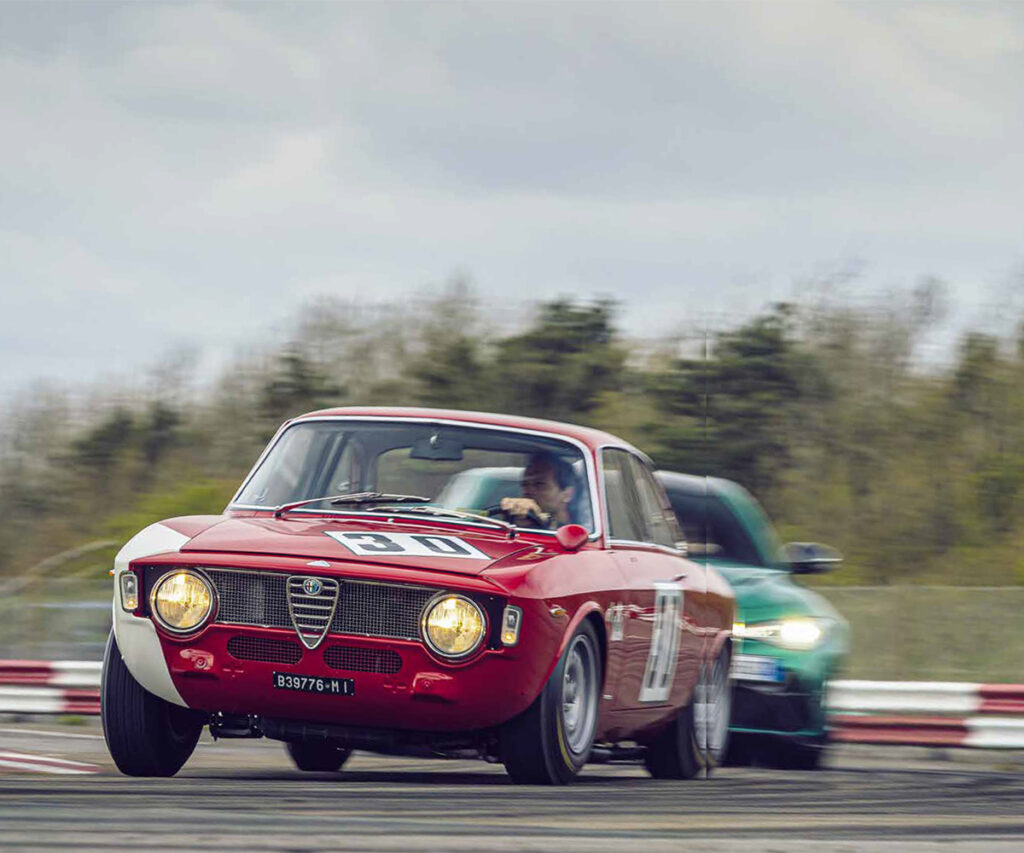
The car’s history and provenance is impeccable, and represents one of the very earliest ‘Corsa’ or race-spec GTAs – the proof is the riveted aluminium floor in addition to aluminium body panels common to all GTAs. Along with Rindt, it was raced by Vaccarella, de Adamich and other Autodelta works drivers in period, and sold to Swedish rally star Ove Andersson once its factory career finished. Later it was squirrelled away in a Swedish collection before Alfaholics bought and restored it, Banks noting it was a golden opportunity to return a GTA to just as it was in period. It retains all its original parts, even the hand-written Prova sheets, like Dead Sea Scrolls for classic Alfa race set-up.
For a genuine touring car, it’s startling how production-spec the interior appears, even if that’s simply what the rules mandated back then. I don’t even notice the rollcage initially, a hoop of black metal tucked behind the B-pillar, diagonal backstays abutting the main hoop
below the glasshouse. You sit low, still with a few inches of headroom if you’re six feet tall, despite the low roof- line, cupped in a seat like a little thimble and surrounded by glass and plastic. Sunlight floods in like a dreamy Super 8 film.
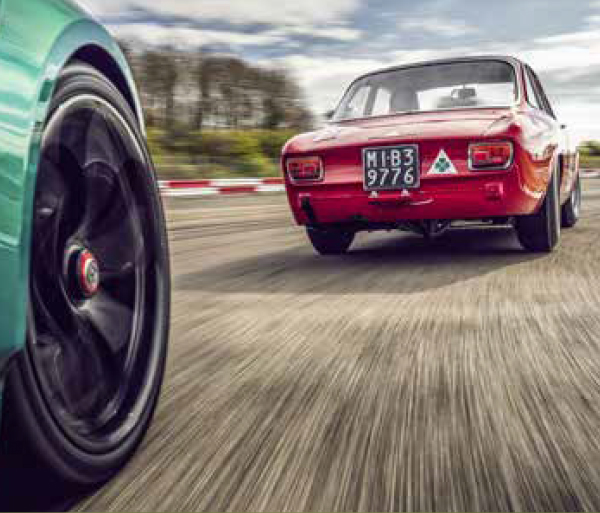
IT’S QUESTIONABLE VALUE FOR MONEY, NO MATTER HOW ENGAGING THE GTAm IS TO DRIVE
The showroom look is in stark contrast with just how noisily this bodyshell fizzes once you’re rolling, even with the side-exit (driver side!) exhaust fitted with a silencer. The engine gurgles and rasps, sucking air through an aluminium cold airbox and fuel through twin 45 DCOE Weber carbs, and you hear the lightweight flywheel chuntering away low in the mix in neutral. The clutch is quite heavily spring-loaded, the gearlever deliciously delicate – it’s positioned far forward on the transmission tunnel, but raked steeply back towards the driver and slots with a long but superbly positive motion.
Short gear ratios keep you mostly out of the very low revs where the twin-cam can hiccup, so all you really note is an energetic bustle in the midrange, and a helium-like willingness to reach for the sky – I extend it past 7000rpm on instinct rather than curiosity because it sings so sweetly up there, and it feels incorrect to interrupt the flow. Given a kerbweight that’s half the new car’s, the steering is heavier than expected, and it loads up chunkily as the GTA’s body first rolls and then takes a set. Already you’re working physically quite hard, but there’s also very little support from the seats, leaving your upper body to do the lateral bracing. No problem for a few laps, but Banks shows me shots of the cars popping front wheels in the air in period. ‘The races were two hours long –these guys really were heroes,’ he enthuses.
Load the car into a tighter corner and there’s a lovely positivity to the Rindt-spec set-up, like it’s up on tip-toes, keen to take a swipe at the apex, and the original Colotti LSD – again set-up exactly in period – is tight too, ready to be throttle-steered. Everything feels alive. Even the brakes (discs all round) are strong, never mind that the remote servo-assisted pedal is a little soft and that I fluff a few heel-and-toe downshifts because my long legs snag the steering. I could drive until the tank runs dry.
Max Banks has grown up with Alfas because dad Richard began buying and selling the 105-series models in the ’70s (and coined the Alfaholics name around 1999, originally for social events) and recalls his dad bringing back ‘a couple of GTAs from Italy in the early ’80s that were £5k-£8k’. These days the bottom of the market is £150k, this one at the top at £1.2m – though it’ll never be sold in Max’s lifetime.
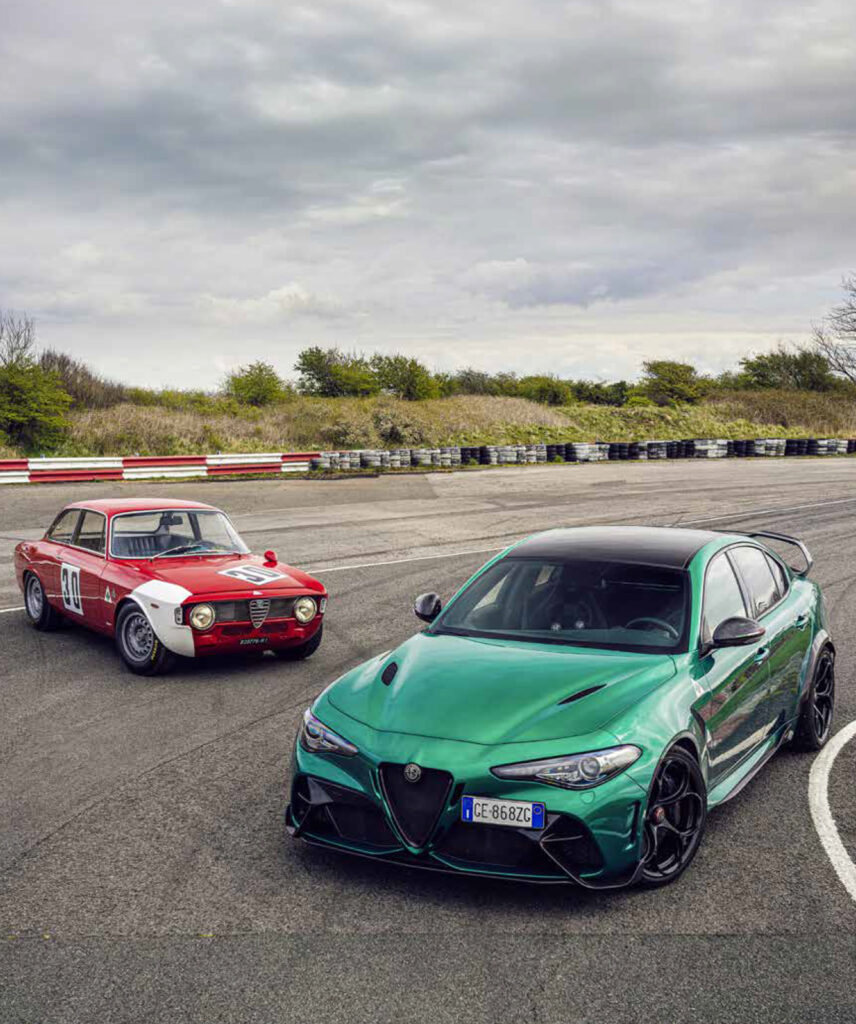
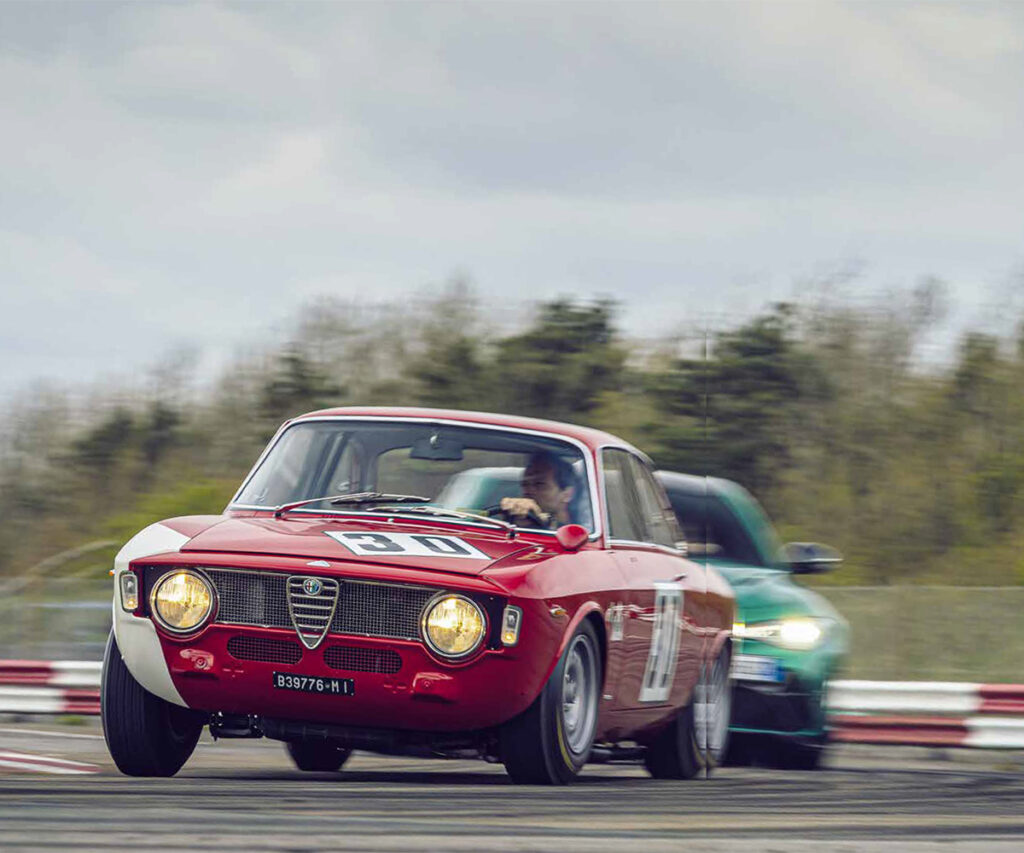
Its value flatters to make the new GTAm look affordable at €180,000, but it’s still questionable value for money no matter how engaging the drive – the content added can’t possibly total £90k or so over a Quadrifoglio, and while there’s still an expectation that these limited- edition hardcore machines will only appreciate, values of the Jaguar Project 8 and M4 GTS prove otherwise.
Banks shares some of the scepticism, but adds: ‘There’ll be Alfisti out there who just have to have the new GTA in their collection, regardless, and actually we have three or four customers who are buying one, and Alfa will no doubt sell them all.’
My take? Let those dedicated buyers take the inevitable depreciation hit, then snap up a GTA (rear seats and all) as the most accomplished and usable high-performance Alfa in decades, if not one that could ever match the provenance of the little red featherweight raced by Jochen Rindt back in ’66.
GTA Old & New
Body
New GTAm
Carbonfibre front bumper, wings, bonnet and roof. Sauber expertise fed into aero kit (standard on GTAm, optional GTA). Redesigned rear diffuser and new under-body aerofins for up to three times more downforce. New front bumper increases flow of cool air by 10 per cent.
’60s GTA
Peraluman 25 aluminium body panels replace standard car’s steel, there are no bumpers, and even the finishing strips along the doors are around half the thickness. Regular grilles replaced by lightweight mesh. Car wears paint scheme and number 30 from Jochen Rindt’s Swedish win.
Chassis
New GTAm
Pitched slightly forwards, the front end 10mm lower, the rear 10mm higher on lighter springs with revised anti-roll bars. Adaptive dampers standard, with GTA-specific tuning. Track 25mm wider front, 50mm wider rear. Forged 20-inch alloys with centre- lock fasteners. Brembo carbon- ceramic brakes
’60s GTA
Autodelta mods included bespoke springs, anti-roll bars, new rear axle, uniballed trailing arms, different front uprights with single rather than twin leg for bottom wishbone pick-up. Alfaholics car uses period Prova (‘set up’) sheets to dial in exact suspension spec. Campagnolo magnesium wheels
Interior
New GTAm
Dash gains stitched alcantara highlights and door pulls, carbon-shelled Sabelt bucket seats, six-point harnesses. GTAm also removes rear bench, leaving storage compartments with nets to secure crash helmets plus a fire extinguisher, rear rollcage, and fixed Lexan rear screen and side windows.
’60s GTA
Autodelta mods included bespoke springs, anti-roll bars, new rear axle, uniballed trailing arms, different front uprights with single rather than twin leg for bottom wishbone pick-up. Alfaholics car uses period Prova (‘set up’) sheets to dial in exact suspension spec. Campagnolo magnesium wheels
Powertrain
New GTAm
The Giulia’s 2.9-litre biturbo V6 gains only 30bhp, for 533bhp, but the turbochargers get more rpm, uprated conrods and extra piston oil jets and fresh ECU tuning. Also new Akrapovic exhaust with twin outlets. Gear ratios/ final drive/LSD as per Quadrifoglio, but with bespoke software calibration.
’60s GTA
GTA’s 1.6-litre twin-cam four made up to 170bhp in Corsa race trim at 7600rpm. Mods include high-compression pistons, Weber 45 DCOE carbs, twin-spark ignition, gas-flowed head. Also magnesium sump, transmission casing and cam coversto reduce weight. Drilled gears, hollow shafts.
Alfa Giulia Sprint GTA Corsa
| Price | £1.2m |
| Powertrain | 1570cc 8v four-cylinder, five speed manual, rear-wheel drive |
| Performance | 164bhp @ 7600rpm, 122lb ft @ 6500rpm, 6.0sec 0-62mph, 128mph |
| Efficiency | n/a |
| Weight | 740kg |
Alfa Giulia GTAm
| Price | €180,000 (£156,000) |
| Powertrain | 2891cc 24v twin-turbo V6, eight-speed auto, rear-wheel drive |
| Performance | 533bhp @ 6500rpm, 443lb ft @ 2500rpm, 3.6sec 0-62mph, 186mph |
| Efficiency | 26mpg (est), 244g/km CO2 |
| Weight | 1520kg (est) |
GTA Old & New Video
Autodelta 1300 GT Junior Build
We have completed the restoration back to the cars exact period specification as built by Autodelta in 1967 with great care and attention paid to retaining as much originality as possible. Road testing is completed and the car ready to ship.

